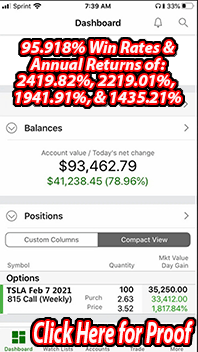Options Swing Trading: What Is It and How Start (Plus Pros and Cons)
 Options swing trading is an attractive form of trading for many investors due to its potential for high profits that can happen in a relatively short amount of time. In this article, we will discuss what swing trading is and how to start, as well as some of the pros and cons of options trading associated with it.
Options swing trading is an attractive form of trading for many investors due to its potential for high profits that can happen in a relatively short amount of time. In this article, we will discuss what swing trading is and how to start, as well as some of the pros and cons of options trading associated with it.
What is Option Swing Trading?
Option swing trading is an investment strategy that involves taking advantage of short-term price fluctuations in the stocks, commodities, or derivatives markets. It involves buying and selling options contracts, which gives investors access to more leverage than stocks and the ability to generate potential profits from both rising and falling markets. Swing traders typically hold their positions for a few days to a few weeks, taking advantage of the price movements between the entry and exit points. This strategy can be used to generate steady profits for traders with the right knowledge and understanding of how to use it properly, and it’s often where most trading options for beginners starts.
Different Swing Trading Strategies
Swing trading is a strategy that traders can use in a variety of ways. The following are some of the most popular swing trading strategies that you can adopt:
Trend-Trading
Identifying a stock in an upward or downward trend and then taking a position in that direction is known as trend trading (ie. buying an uptrend or selling short a downtrend). Technical analysis tools like moving averages and trend lines are used by trend-following traders to identify the direction of the trend and to decide when to enter and exit positions. These are often the type of trades initiated by altcoin trading signals companies.
Momentum Trading
Stocks with strong price momentum and rising volume are the focus of the momentum trading strategy. A very reliable form of momentum trading is relative strength trading. To identify momentum and choose when to enter and exit a trade, technical indicators like the Moving Average Convergence Divergence (MACD) and Relative Strength Index (RSI) are also used. These are used almost exclusively when it comes to momentum trading crypto.
Breakout Trading
Buying stocks that are breaking out of a trading range and then taking a position in that direction are the main goals of breakout trading strategies. This technique, like trend-following, largely depends on technical analysis tools, like as volume and chart patterns, to identify breakouts and determine when to buy and sell.
Pullback Trading
Pullback trading is a popular strategy used by traders to take advantage of short-term price movements in the financial markets. At its core, pullback trading involves identifying an asset that has been trending in one direction and waiting for it to experience a brief retracement or “pullback” before entering a position. The idea behind this approach is that while market trends can be volatile, they tend to move in cycles. When an asset experiences a pullback, it provides an opportunity for traders to buy at a lower price point and potentially profit when the trend resumes. This allows traders to enter positions with reduced risk compared to buying at the top of an upward trend.
Mean Reversion
In a mean reversion strategy, a stock that is substantially deviating from its historical average price is identified, and a position is taken in the hope that it would eventually revert to the mean. Statistical methods like Bollinger Bands are frequently used by mean reversion traders to identify equities that are trading outside of their regular ranges and to help them decide whether to buy or sell.
News-Based Trading
News-based trading strategy is a powerful tool that traders use to make better-informed decisions. This strategy involves analyzing news events and their potential impact on the markets, then using this information to buy or sell stocks at the optimal time. Essentially, it’s all about taking advantage of market volatility caused by news releases.
Arbitrage
The arbitrage strategy entails profiting from differences in a stock’s price across markets or across various financial instruments. For instance, a trader might purchase a stock on the open market while also selling a futures contract on it. The pricing disparity results in a profit.

Day Trader vs. Swing Trader
Day trading and swing trading are two popular forms of investing, but they differ greatly in their approach. Day traders take advantage of small price movements during a single trading day, while swing traders look for larger price movements that occur over several days or weeks.
The primary difference between these two strategies is the timeframe used to achieve profits. Day traders typically use shorter time horizons to buy and sell securities quickly throughout the trading day, whereas swing traders may hold their positions for many days or even weeks before taking action. As a result, day trading can be more active and risky than swing trading since more trades are made on a daily basis which can lead to higher losses if not managed properly. On the other hand, swing trading offers more stability since fewer trades are made each week, making it easier to manage overall risk.
What are the Pros of the Options Swing Trading Strategy?
There are advantages that swing trading offers and some of that benefits are the following:
Requires Less Time to Trade
One of the biggest benefits of swing trading is that it only requires less time to trade compared to other strategies. Swing traders typically hold stocks for a few days up to several weeks, allowing them to capitalize on short-term price movements. With swing trading, you don’t need to constantly monitor the markets throughout the day like day traders do. Instead, you can check in on your positions periodically and make adjustments as needed. This makes it an ideal option for those with full-time jobs or other commitments who don’t have the luxury of dedicating hours each day to trading.
Maximizes Short-Term Profit
Swing trading provides traders with the opportunity to take advantage of short-term market movements and capitalize on price fluctuations. By holding positions for a shorter period, traders can reap profits quickly and move on to their next trade. This type of trading approach allows traders to take advantage of market volatility, which can be beneficial in a fast-paced market environment. Traders who are skilled at identifying trends and patterns in the markets can often make profitable trades by buying low and selling high, or vice versa. This type of investing style requires discipline, patience, and risk management skills, but if executed correctly, it can lead to significant financial gains.

Swing Traders can Rely Exclusively on Technical Analysis
Swing traders can rely exclusively on technical analysis when making their trades. Technical analysis uses chart patterns and trends over time to determine when an asset may be undervalued or overvalued. This type of analysis simplifies the trading process for swing traders by allowing them to focus solely on the charts rather than fundamentals such as earnings reports or company news. Technical analysis also helps identify entry and exit points for trades more quickly, helping swing traders stay ahead of the game.
What are the Cons of the Option Swing Trading Strategy?
Despite the swing trading popularity, there are some cons associated with it that must be considered before taking this approach. Some of that cons are the following:
Possible Exposure to Overnight and Weekend Price Gaps
Overnight and weekend price gaps occur when a security opens at a much higher or lower than it closed the previous day due to news occurring outside of regular trading hours or during holidays when markets are closed. This can significantly increase losses if the trade position was not held through the gap period, as they will be subject to any sudden shifts in price movement.
Possibility of Missing Exceptional Stocks
Swing trading seeks to profit from brief price swings. When attempting to enter at the start of a swing and exit when a pullback begins, you miss out on an opportunity to take advantage of a good stock that would have made more profit if it had been held as a long-term investment. Examples of such stocks are Amazon, Apple, and Tesla.

Market Timing Might Be Difficult
Even professional swing traders understand it’s not always feasible to successfully time the market’s swings. Those who are just getting started will need to face this difficulty as well.
How Do You Trade Options in Swing Trading?
Option swing trading can be a profitable way to add diversity to your portfolio, as well as increase your income potential. Here are some tips for how to do option swing trading successfully.
Step 1: Choose an asset
Choose an asset that you think has the potential for short-term price volatility. Research different stocks, indices, commodities, currencies, or other assets that have been trending up or down recently and look at their historical charts to assess possible entry points. Make sure you choose an asset with plenty of liquidity in order to easily open and close positions when necessary.
Step 2: Choose a Direction
When deciding which direction to take, traders must consider their risk tolerance, market outlook, and available capital. Traders should also consider the time frame they are working within as this can have an effect on the strategies employed. Before taking any positions, it is important to research the underlying asset and gain an understanding of its fundamentals as well as technical indicators such as support and resistance levels for guidance on entry and exit points. Additionally, traders should always set stop losses when entering into any position in order to limit downside risk.
Step 3: Pick a Strike Price
A strike price is a predetermined price at which an option contract can be bought or sold. The strike price should be chosen carefully, as it will determine how much profit or loss an investor incurs if they exercise their option contract prior to expiration. When selecting a strike price, traders should consider factors such as volatility, liquidity, and current market conditions. If volatility is high, then traders should look for strikes that are further away from the underlying stock’s current share price – but remember that those options will also cost more money upfront!

Step 4: Determine the Number of Trades You will Do Each Week
Determining how many trades you will do each week is very important. This decision should be based on your risk tolerance, available capital for trading, and your investment goals. It’s important to maintain realistic expectations when setting this number, doing too many trades could lead to excessive losses due to market volatility or a lack of proper research. On the other hand, not doing enough trades could leave you missing out on potential profits if the market moves in your favor.
Step 5: Decide on an Expiration Date
This simply refers to the date by which time the options must be exercised or expire worthless. When deciding on an expiration date, traders need to consider how long they have until their forecasted price movement will occur. Typically, traders should choose options with at least 30 days left before they expire as this allows enough time for their projected price move to happen before expiry. Shorter-dated options are riskier as there may not be enough time for their forecasts to materialize and therefore can lead to losses.
Step 6: Time Your Entry
When it comes to option swing trading, the key point is that you need to buy when the stock price is low and sell when it’s high. This means that you need to time your entry into the market in order to maximize your profits. To do this, you should look at various technical indicators such as moving averages, support and resistance levels, and other chart patterns. You can also use fundamental analysis techniques like analyzing earnings reports or news events that could affect the stock price in order to enter a position at just the right moment. Finally, don’t forget to factor in both risk management strategies as well as market sentiment before making any final decisions on entering or exiting a trade.
Step 7: Execute Your Trade
When it comes to executing your trade, it pays to be mindful of both risk management and your personal goals for returns. Risk management includes setting predetermined stop-losses so that losses are minimized if the price moves in an unfavorable direction, these will vary depending on each individual trader’s style.
Step 8: Manage the Position
Managing a position means being aware of the current market conditions and reacting accordingly when needed. If the stock moves against you, take steps to limit losses or close out the trade altogether. On the other hand, if the stock moves in your favor you should consider locking in profits by either closing out or adjusting your existing positions. Additionally, traders may consider buying additional options contracts if they feel their thesis is still valid. Of course, if you’re confused on how to do this, you may want to check out our review of the best options services available at http://kingtradingsystems.com/best-stocks-options-advisory-service-reviews.php or you can visit a site like The Empirical Collective who are one of the best options trading services on the market.
Frequently Asked Questions
Are options good for swing trading?

Options allow investors to control larger positions with less capital, reducing risk and allowing them to generate greater profits. This is one of the main advantages of using options for swing trading as it allows investors to better manage their portfolios. Options also allow investors to take advantage of leverage, which can amplify gains or losses depending on how the trade is managed. Overall, options can offer several advantages for swing traders looking for short-term gains from stock market volatility.
Is swing trading profitable in options?

The potential gains from swing trading options are significant as traders can take advantage of short-term price movements to generate profits. In addition to that, as most options contracts are relatively inexpensive compared to stocks, investors may also benefit from margin leverage when using certain strategies such as spreads or straddles. However, it is important to note that these strategies carry additional risk due to their complexity and require more capital outlay than simply buying and selling stock without leveraging up.
What are some indicators or tools used by swing traders?
Which types of securities are best-suited for swing trading?

While a swing trader can be successful in a variety of assets, large-cap stocks—which are among the most actively traded equities on the main exchanges—tend to be the greatest choices. These stocks frequently fluctuate between widely defined high and low points in an active market, and a swing trader will ride the wave in one way for a few days or weeks before switching to the other side of the trade when the stock reverses course. In markets like commodities and FX that are actively traded, swing trades are also possible.




